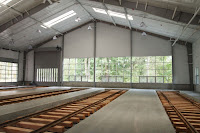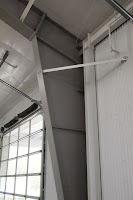PART I
In one sense, forestry was the Northwest’s “green” industry of the last two centuries. The Train Shed will convey part of that story while simultaneously embodying today’s green industries, such as energy efficiency, local and recycled materials, and stormwater management.

 Climate control is highly important to a museum collection. But the Train Shed is not air conditioned. To regulate temperature, the building relies on automatic louvers, large ceiling fans (which also prevent pockets of moist air from settling) and heavy insulation. The US Department of Energy recommends an R-value of R-16 to R-21 for home wall insulation in King County. The higher the R-value, the greater the ability to resist heat flow. The Train Shed’s wall insulation is R-38.
Climate control is highly important to a museum collection. But the Train Shed is not air conditioned. To regulate temperature, the building relies on automatic louvers, large ceiling fans (which also prevent pockets of moist air from settling) and heavy insulation. The US Department of Energy recommends an R-value of R-16 to R-21 for home wall insulation in King County. The higher the R-value, the greater the ability to resist heat flow. The Train Shed’s wall insulation is R-38.  The building’s design utilizes natural lighting. Thermopane windows (which open) are made of special glass that lets in light while blocking 95% of the sun’s damaging ultraviolet radiation. Typical window glass keeps out about 30%. Where natural light needs to be supplemented, metal halide fixtures provide bright, energy-efficient lighting. Exit lights are LEDs.
The building’s design utilizes natural lighting. Thermopane windows (which open) are made of special glass that lets in light while blocking 95% of the sun’s damaging ultraviolet radiation. Typical window glass keeps out about 30%. Where natural light needs to be supplemented, metal halide fixtures provide bright, energy-efficient lighting. Exit lights are LEDs.  The project incorporates a number of recycled and locally produced materials. Steel columns and beams were fabricated in Arlington, about 90 minutes north of the Museum, at BlueScope Buildings North America, Inc. Interior and exterior cladding is recycled steel, manufactured by AEP (owned by BlueScope) and rolled in Washington.
The project incorporates a number of recycled and locally produced materials. Steel columns and beams were fabricated in Arlington, about 90 minutes north of the Museum, at BlueScope Buildings North America, Inc. Interior and exterior cladding is recycled steel, manufactured by AEP (owned by BlueScope) and rolled in Washington. CalPortland provided concrete and crushed rock from its facility across the Snoqualmie River next to the former Weyerhaeuser mill site. The exhibit building’s low-maintenance polished concrete floor is longlasting and easy to vacuum. The Mt. Si Quarry, just up the road from the Train Shed, produced crushed rock for the sub-ballast.
 Tomorrow we’ll tell you about permeable surfaces, native soils and vegetation, and our preferred alternative to creosote ties in Old green, new green: Part II.
Tomorrow we’ll tell you about permeable surfaces, native soils and vegetation, and our preferred alternative to creosote ties in Old green, new green: Part II.

2 comments:
I see ties (and eventually rails) laid right up to a single door in the back. Where will this lead to? Is a turntable planned in the future?
Good eye, thanks for asking! There may be a turntable in the distant future, but this track would not lead to it. The exhibit building is designed for maximum interpretive potential. These rails will furnish a short expanse of outdoor exhibit track, and then simply disappear into the forest behind the Train Shed to convey more of the look and feel of this region's early railroads.
Post a Comment